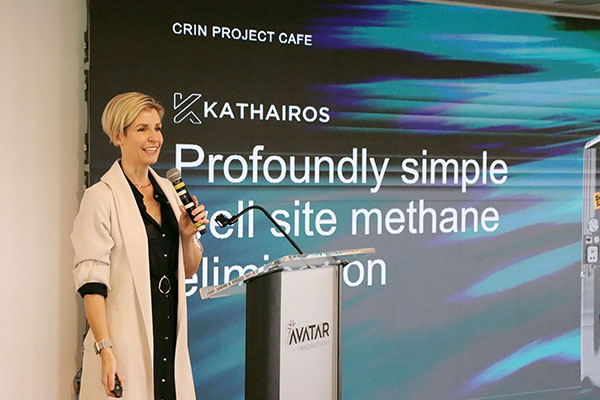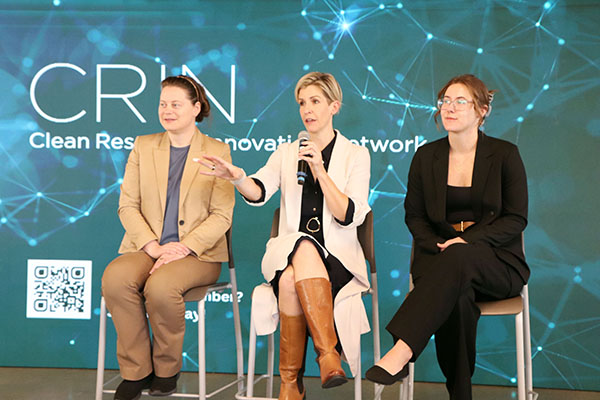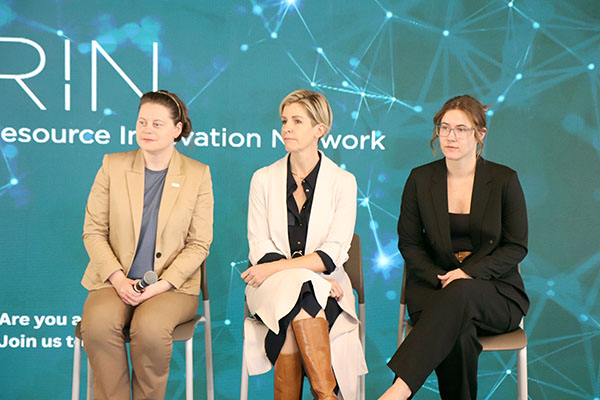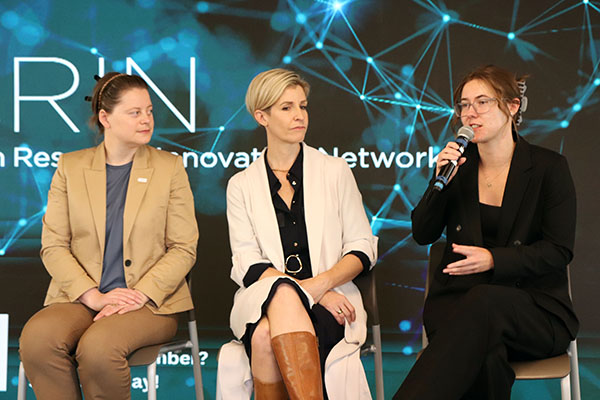Oct 10, 2024




Event Recap: Project Café featuring Kathairos, OptiSeis, and Scovan
Receiving funding from CRIN in 2022 was a “huge game changer” for Kathairos, which has grown from two producer partners and 60 well sites then to about 60 active producer partners and tens of thousands of wells currently.
“It was literally the starting point for Kathairos,” Chief Marketing Officer Kelly Doody said during a Project Café presentation on October 8 at the Energy Transition Centre.
Kathairos was one of three companies, along with OptiSeis and Scovan, presenting their progress on CRIN-funded projects at the first October instalment of the Project Café event series.
All three presenters described the project funding they received from CRIN as “instrumental” to advancing their technology.
The fact that two big companies (Ovintiv and Cenovus) put up their hands when Kathairos was receiving the CRIN funding spoke to not only their belief in technology but “how much they believed in CRIN and that they knew that this was a partnership and a project that would be successful,” Doody said.
The Kathairos technology, manufactured by Chart Industries, focuses on methane elimination from remote well sites. The system stores liquid nitrogen in a standalone tank and vaporizes it into inert nitrogen gas used to actuate well-site pneumatics at the volume and pressure they require. The result is an off-grid power source that runs on the laws of thermodynamics.
Traditionally, natural gas well sites have relied on methane to operate their pneumatic devices, resulting in methane venting. “The opportunity for an off-grid, affordable and effective, reliable solution was desperately needed,” Doody said.
She likened the tank system to a “large Yeti cup.”
“We put liquid nitrogen inside, refill it once a month, and then the tank, just through the fact that liquid nitrogen wants to escape back to being nitrogen gas, just like in your coffee cup, as it warms, it expands into gas, and it expands by 700 times,” she said. “So, it provides an excellent inert, clean, emissions-free fuel source for the pneumatic devices…Then it’s vented back to air, and nitrogen makes up 78 per cent of the air we breathe.”
The problem OptiSeis set out to solve with its EcoSeis project was seismic cut lines.
To drill wells, an image of the subsurface is required. If the well sites are in a remote, treed area, lines must be cut to safely deploy the equipment.
“So, the challenge that we set out to solve was, how can we get really good quality subsurface data and reduce the number of surface cut lines,” said Andrea Crook, Co-Founder and CEO of OptiSeis.
As part of its integrated solution, EcoSeis, OptiSeis looked at making the cut lines narrower and miniaturizing equipment and enhancing the miniature sources.
“The other thing that we looked at is, of course, cutting fewer lines, but if we're going to go to alternative sampling, yes, we can reduce the line density, but we still need to make sure that it's safe the way we deploy these, and that we're going to get good processing out of the data,” Crook explained. “We also, when we’re looking at a full solution, we want to consider the environmental constraints in the area that we’re working in.”
CRIN was instrumental in 2022 in helping OptiSeis go to the field and verify that with these new designs, subsurface resolution could be maintained.
“To do this, we had to go and acquire comparison data sets,” she said. “The other part of the goal of the project was, whatever we do in the field needs to be safe and efficient, and if we can do this at the same or reduced cost, then we have a winning solution that's actually going to be adopted.”
The project has resulted in a 45 to 55 per cent footprint reduction, depending on how the technology was deployed, Crook said.
She added that EcoSeis has been a very collaborative project through the CRIN network, resulting in direct collaboration with 30 companies and indirect benefits to another dozen companies through the project. OptiSeis has done field trials and is moving onto full commercialization, with a team that has grown from three employees to nearly 20 employees and consultants.
HipVap is a unique technology that allows the elimination of much of the upstream water, de-oiling and treating processes conventionally used in SAGD.
“The technology takes produced water straight from the free water knockout and runs it in a loop, where 20 per cent quality steam is generated,” said Emily Munro, Innovation Engineer in Training at Scovan. “This allows the tubes to remain wetted, therefore eliminating scale formation alongside a chemical dosing program.”
Overall, the technology can convert up to 90 per cent of the feedwater into steam, Munro added.
The goal of the pilot project funded by CRIN was to advance the technology readiness level (TRL) of the technology from six to eight, the last major step for commercialization, and to co-develop an AI machine-learning platform that can help optimize and advance the HipVap operations.
Some of the pilot project’s successes to date include the generation of more than 10,000 cubic metres of steam, the successful completion of several test series, and the development of a data visualization and analytics platform, along with a digital twin and soft sensors.
Scovan will continue the last stages of testing until the end of November 2024.
“We have lots of opportunities going into our final stage of the testing and commercialization of this technology, including technology suppliers that are looking to help us further reduce the carbon footprint of the technology,” Munro said.
“We also are interested in partnering with chemical suppliers who could offer cost savings for the technology. And finally, any end users wishing to do further testing or support specific use case testing, or, in particular, engage in a feed study for the first commercial installation of this product, we are very interested in speaking to you.”